
Updated July 2022
Café Viet is a way of life in Vietnam – from first light until darkness, local cafes are full of people meeting to not only sip Vietnamese coffee but to socialize, watch the world go by, work, play cards or chess, or just enjoy the atmosphere. If you fancy yourself as a coffee connoisseur and haven’t yet tried it the Vietnamese way, you’re in for a truly wonderful experience. Find all you need to know below.
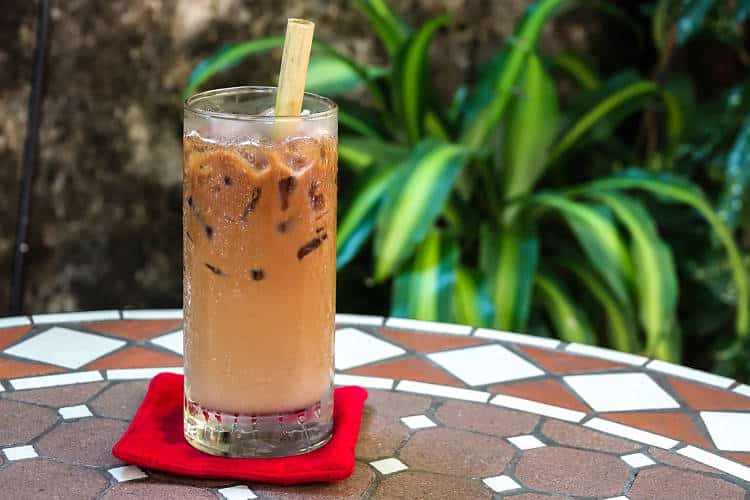
Robusta Vietnamese Coffee Beans
The typical coffee bean grown in Vietnam is the Robusta, although Arabica is grown also. Robusta is rightly-named because it packs a cracking caffeine punch of 2.7%, almost double the 1.5% Arabica, which one finds in most cafes in the West.
Robusta is served in most Vietnamese cafes but others will serve Arabica also and some offer a mixed blend. If it’s a true taste of Vietnamese coffee you’re after, look out for Robusta but keep in mind your blood pressure! The taste is also quite unlike the Arabica blends you may be used to, being stronger and much more bitter – think proper dark chocolate compared to milk, and you’re halfway there.
Vietnamese Coffee on the Street (Cà Phê Cóc)
Although coffee wasn’t introduced by the French until 1857, Vietnam is now second only to Brazil as the largest exporter in the world. Throughout Vietnam you’ll find coffee shops of all styles, prices and sizes but if you want to see the ‘real’ coffee culture of Vietnam look no further than your street corner.
Along every sidewalk or corner are the ubiquitous Ca Phe Coc street coffee vendors. These are makeshift affairs involving nothing more than a dozen or so tiny, plastic, red chairs and tables precariously perched on the side-walk by some busy road. Their seriously-good coffee is cheap and the experience is quintessentially Vietnamese. It’s here that people – young and old, rich and poor – can smoke, shout, gossip, play cards, street watch or simply get lost in thought.
What Makes a Good Vietnamese Coffee?

Coffee Hanoi-style 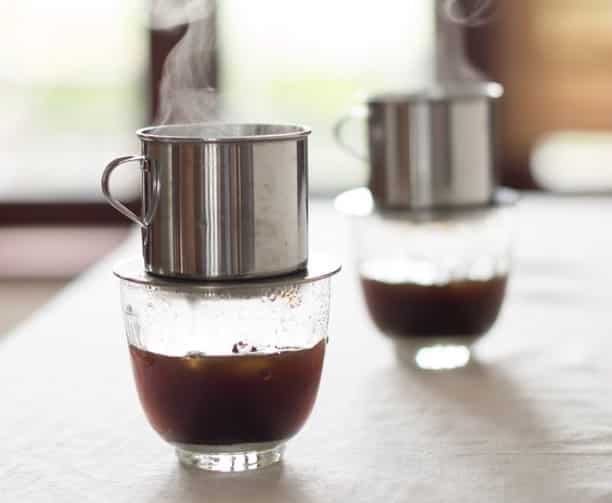
Coffee dripped through a phin
Strength is important in the search for good Vietnamese coffee of course, but beyond that, a lot depends on your age and location. Northerners tend to prefer a shorter coffee, known countrywide as ‘café Hanoi’. In the south, coffee is often served longer, in a tall glass – known countrywide as ‘café Saigon’.
Different cafes in Hoi An may have a preference for serving one or the other, but will usually serve both, so if you’re not one for surprises, stipulate your preference when you order.
The two main styles are black (café den) and with milk (café sua). This is usually condensed milk, a leftover from French rule. As the French couldn’t easily acquire milk, condensed milk was brought in and became a sweet hit across the country.
Types of Vietnamese Coffee
Whichever coffee you go for, it’s usually accompanied by a glass or jug of either iced or lukewarm green tea. The tea is mild in flavour and comes at no cost. It acts as a wonderful mouth cleanser between sips of your coffee and helps balance the strong flavour. You’ll find the combination works like an absolute treat – similar to balancing a single malt whisky with sips of mineral water.
Traditional Vietnamese coffee is made using a phin – this is the name of the metal device with a ‘sieve’ at its base. Hot water is poured onto the crushed Robusta beans and a steady flow drips through the coffee into your glass. Sometimes you’ll simply receive the finished product of a glass of coffee, other cafes will bring the phin to your table.
Unless you specify in advance, many cafes will automatically serve your coffee with sugar – this does counterbalance the strong taste of the Robusta blend, tastes fantastic and gives you a remarkable kick first-thing in the morning – but it isn’t to everyone’s taste. So if you want to go sugar-free, try asking for ‘khong duong’ (pronounced ‘khawm dur-uwm’).
Iced coffee is very popular in Vietnam, and when the temperature’s over 30 degrees, you’ll soon understand why!
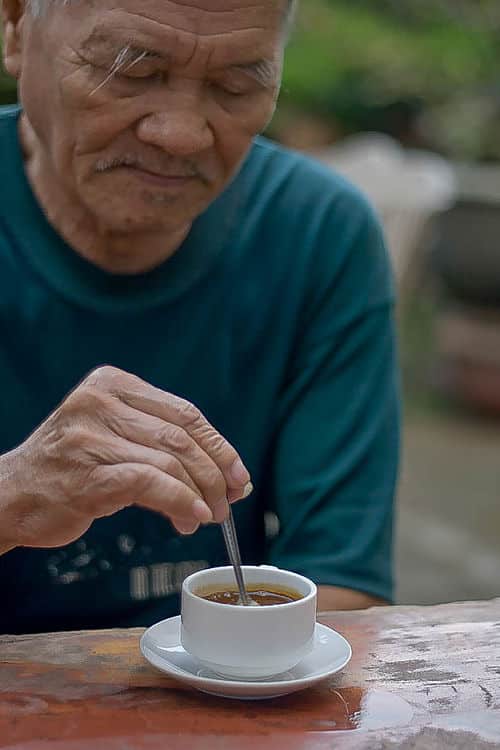
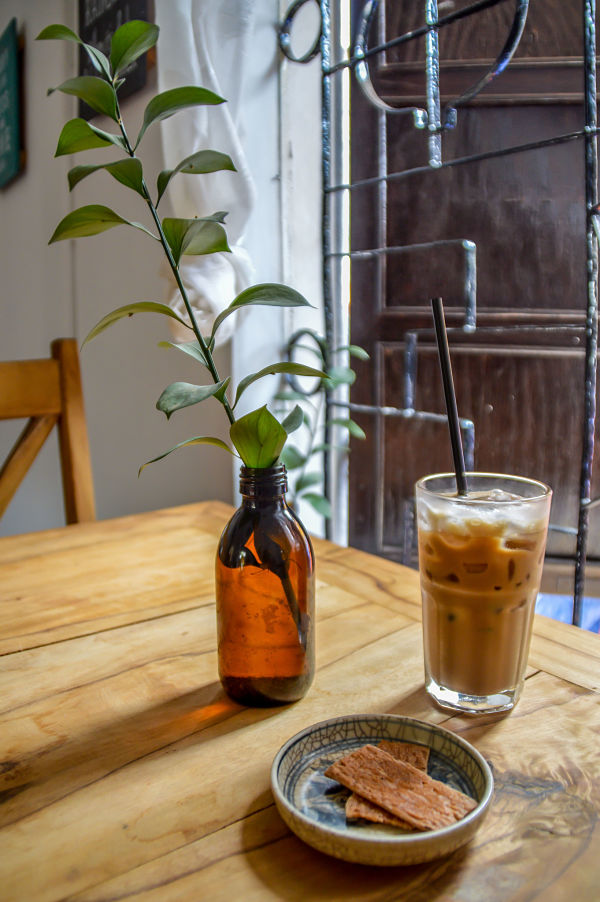
Black Coffee
‘Café den’ can be served hot (‘café den nong’) or with ice (‘café den da’). The iced version also comes in the two styles mentioned above – ‘café den Hanoi’ for short black coffee, and ‘café den Saigon’ for long black coffee.
Coffee with Milk
‘Café sua’ can also be served in the styles described above. Most will come with condensed milk. A lighter-coloured drink will already have been blended, but if your café sua looks suspiciously dark, give it a good stir prior to that first sip to mix the two together.
Coconut Coffee ‘Ca Phe Dua’
This coffee has exploded in popularity in recent times and it’s not hard to see why. Maintaining a robust coffee bite, the mix of coconut cream, condensed milk and ice all combine to create a deliciously refreshing drink with a beautiful coconut aftertaste. Vegan versions are available in many places, swapping the dairy milk for soya or coconut milk.
Egg Coffee ‘Ca Phe Trung’
If you like sweet coffee that is more akin to a milkshake made by a 5 year old who’s been let loose on the sugar bowl, then Egg Coffee is for you. Don’t get on the scales after drinking! Like Coconut Coffee, Egg Coffee originates from Hanoi and is made by combining coffee, fluffy egg yolk and condensed milk to create a drink like a frothy ice-cream dessert.
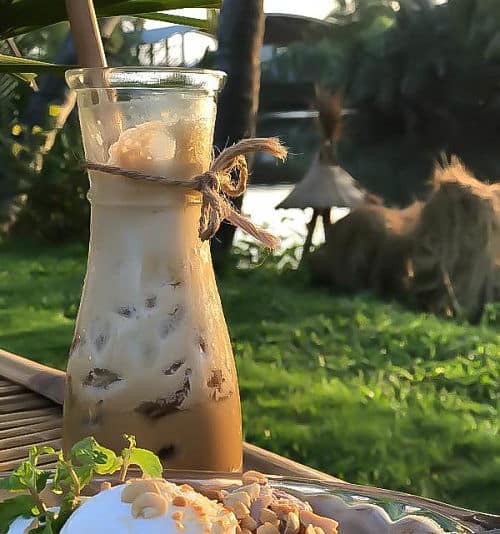
Coconut coffee’ combines coconut cream, condensed milk, coffee and ice 
Egg Coffee combines fluffy egg yolk, coffee and condensed milk
Weasel Coffee
Weasel coffee (Kopi Luwak) is a very expensive, novelty coffee and very popular as a tourist gift. Weasel coffee has passed through the stomach of a civet – what funnier present could you buy for that person back home than ‘poop’ coffee from Vietnam? Before you buy, however, you might like to know a little bit about the dark side to this coffee.
What do Vietnamese People Look For in a Cafe?
Vietnamese people (especially the young) like to be connected. Good WiFi is an absolute must for any cafe.
Next and of the upmost importance is ‘the view’. You see, Vietnamese people love to gossip and be among it, to see what’s going on. Therefore, the most popular coffee shops are those with good views of the street – busy intersections are best.
It’s here that people can see who’s doing what and with whom and if there’s an incident on the street, well, it all adds up to enlivening an otherwise boring day.
Next is the taste of the coffee – and of course, it’s subjective. But people mostly like a heart-stopping brew that will see you still bouncing off walls 24 hours after your first sip
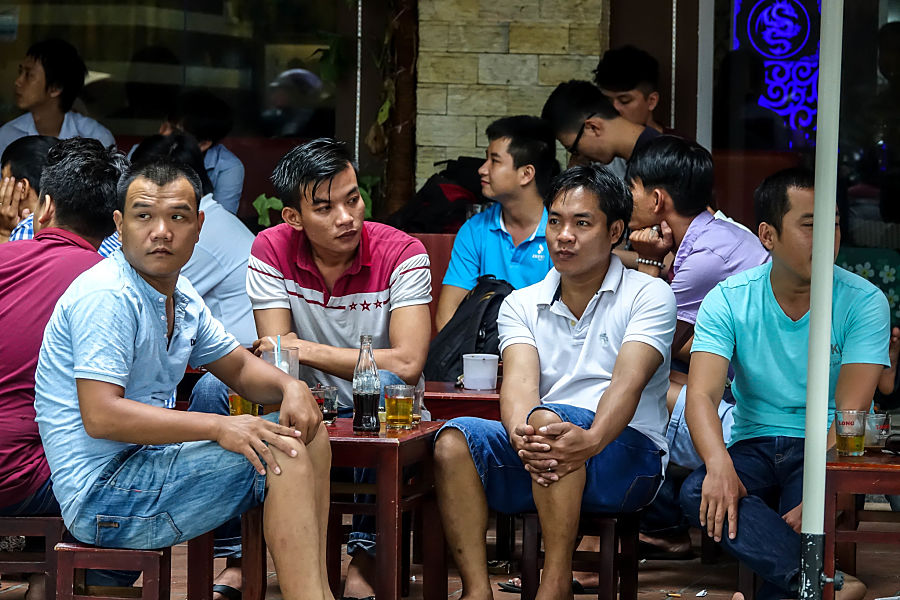
The Art of Ba Tam
What do the Vietnamese go to coffee shops for? Well apart from WiFi and a good coffee, they like to gossip. People who gossip are called: ‘Ba Tam’. Unlike Western types who pretend to disdain such behaviour, the Vietnamese openly embrace a bit of gossip in the full light of day. But it is all meant to be sweet-natured.
The Vietnamese are a communal and inclusive society and deeply interested in each other. A bit of ‘tam’ is a way of bringing people together because a bit of gossip enables you to connect with people and also get to know people you don’t know that well.
It’s fair to say that Westerners have the same impulse but invariably do their best to hide it. Most of us are nosey but it ‘just won’t do’ to show it.
What Coffee tells you about the Vietnamese Character
Ca Phe Sua Da (long coffee, milk & ice)
Drinking the longer-glassed, style of coffee that comes with more ice and milk suggests a softer, easier going person who laughs a lot. Younger people tend to drink coffee with milk.
So, if you want to look young, swag and fun to be with, drink Ca Phe Sua Da!
Ca Phe Den (short, black coffee)
Drinking the smaller black, hotter and thicker coffee suggests a more, serious, introverted, ‘harder’ and (usually) older type of person.
In other words, miserable, old people drink Ca Phe Den!
Check out either of the “ SUA CAFE “ 145/166 Ly Thuong Kiet Tp or Japanese Bridge Sua Cafe for a genuine Vietnamese Coffee or a blended 70/30 more preferred by westerners, by supporting these establishments you
are supporting the less fortunate in the area and also helping employ disabled local people,